Salmon Fishing On The Salmon River NY: Tactics and More
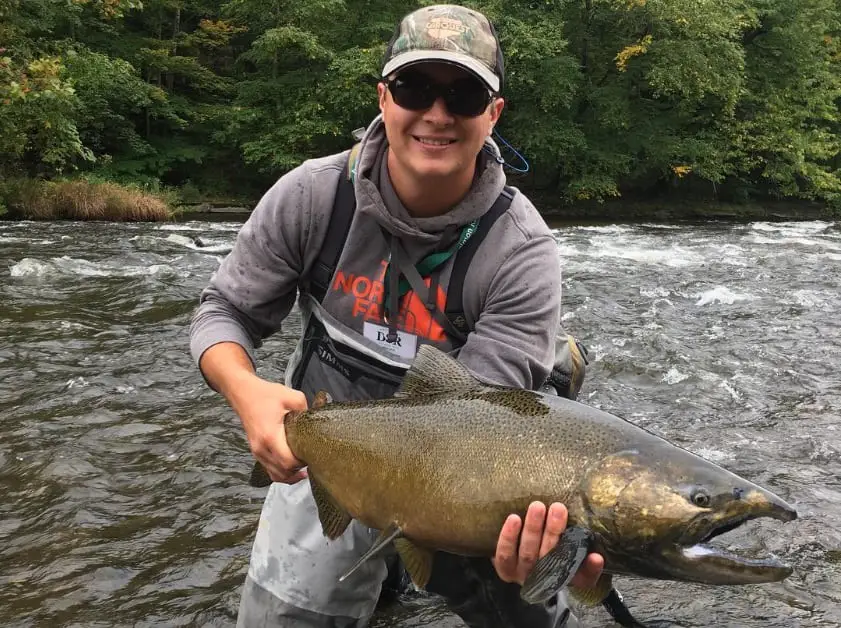
Salmon fishing on the Salmon River in New York can be so good that people from all over the country will visit the area during the two-month window known as the salmon run.
Salmon fishing consists of the prized Chinook salmon, Coho Salmon, and some Atlantic salmon. Huge numbers of salmon move into the river from September through November.
Salmon Fishing On The Salmon River
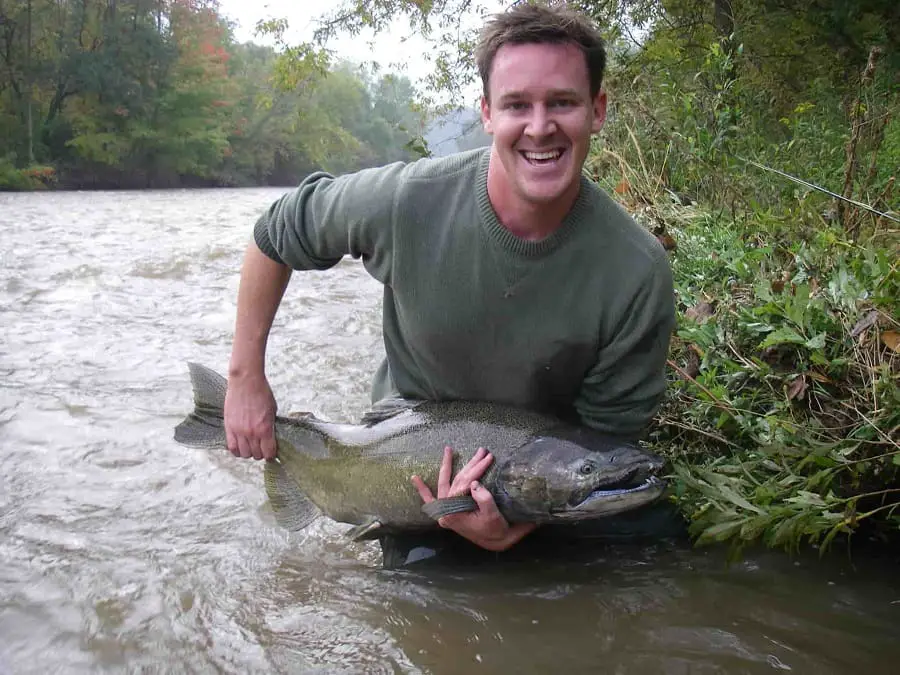
The Salmon River in New York is the most renowned salmon fishing hotspot in the Eastern United States.
The river is famous among anglers who visit to fish for the big Coho and King Salmon, which run the river annually. The river also contains sizable lake-run brown trout and steelhead, which also migrate from Lake Ontario around the same time as the salmon.
Even the rare Atlantic salmon can be caught on the Salmon River. Thanks to ongoing stocking efforts of Atlantic Salmon, frequent catches now occur, and occasionally, anglers will catch Atlantic Salmon up to 20 pounds.
The Salmon River flows from New York’s Finger Lakes region through Pulaski City into Lake Ontario. It is located near Selkirk State Park.
Few places around the Great Lakes region will offer Atlantic Salmon fishing like this.
Annually, the Salmon River is stocked with approximately 80,000 Coho salmon, 300,000 Chinook salmon, and 30,000 Atlantic salmon. This is the major reason why the Salmon River gets such large runs of salmon every fall.
One disadvantage of the Salmon River is the crowds, which can get especially bad on the weekends.
Salmon River Size Records
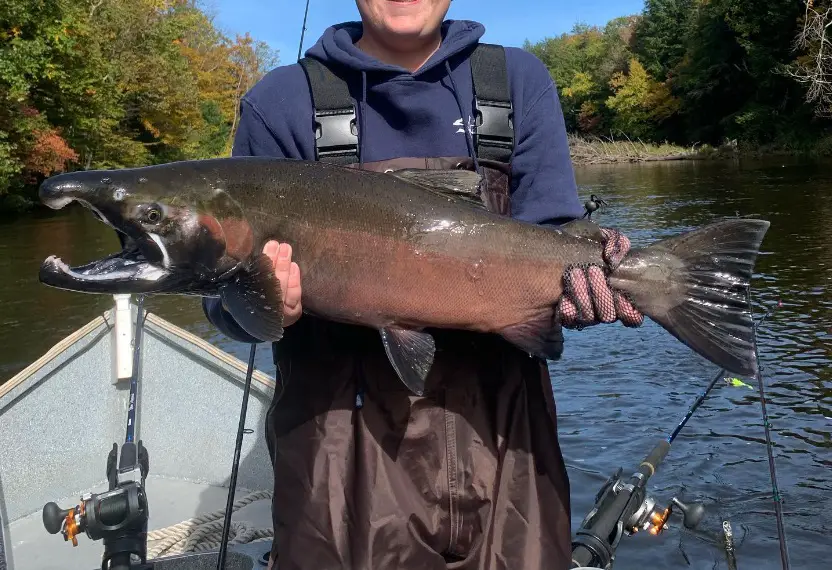
One of the reasons these salmon entice anglers to come such a long way is the abundance of very large salmon. You have a chance to hook over 30 salmon a day that are between 15 and 40 pounds.
Two major salmon size records have been set in the Salmon River. These two records include the record for the largest Great Lakes Chinook Salmon with a huge 47 lbs. 13 oz Chinook salmon, followed by an impressive state and world record Coho salmon, which is 33 lbs. 4 oz.
Water Levels and Fishing
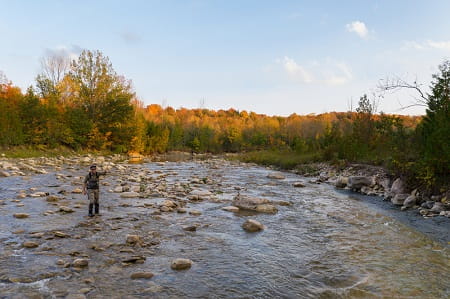
The Salmon River is dam-regulated, which means water levels can rise or drop unnaturally at any time.
The water levels and discharge rates in the river are relatively stable during the summer and fall but can change due to the release of water from the dam or from heavy rains.
There are ways you can find out the water levels before you even leave the house. Check the USGS website at Salmon River at Pineville NY – USGS Water Data for the Nation.
You will want to know the water levels since the water level can trigger salmon runs if they are high or prevent runs of salmon if they are too low.
August often marks the beginning of the fall salmon run with very small sporadic runs of salmon, which often follow rains or increased water levels.
Best Time for Fishing The Salmon River
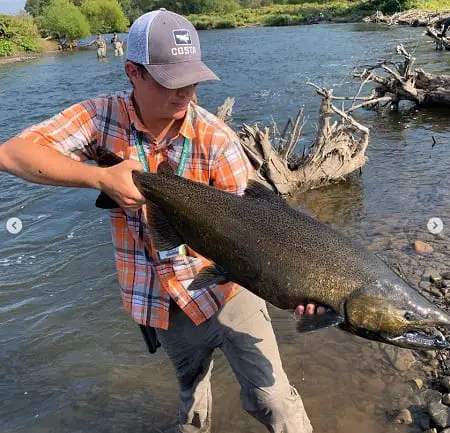
The best time for fishing the Salmon River for Coho and King salmon is usually mid to late September and all of October.
This is because the fish start staging in the estuary by late August, and some will move in and out of the lower river during low light hours.
Anglers will target these close to shore salmon by casting lures or baits, or trolling the river mouths by boat.
The salmon runs are usually at their peak by late September and early October, and the spawning run usually ends by late October, with only older spawned salmon in the river in November.
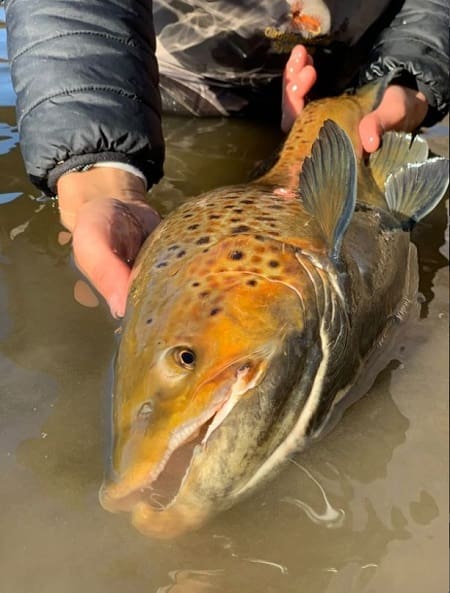
Lake-run brown trout, steelhead, and Atlantic salmon can also be found in the river during this period.
For more information, check out Great Lakes Brown Trout Fishing.
Steelhead can show up as early as September with the salmon. However, the Salmon River steelhead fishing is best after the salmon are done spawning.
There are small numbers of a summer run steelhead known as a Skamania Steelhead. See Skamania Steelhead Fishing: A Complete Guide.
Best Places For Fishing the Salmon River
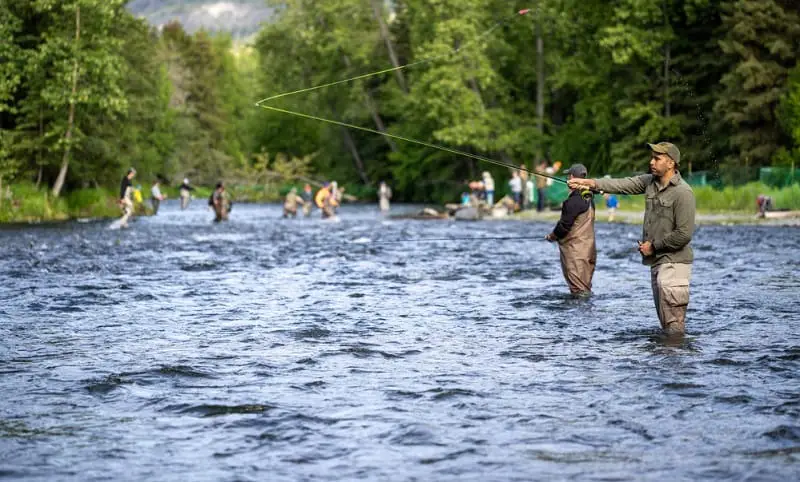
The Salmon River consists of over 13 miles of salmon and steelhead hotspots from the Lower Reservoir Dam to Lake Ontario. The Salmon River’s upper reaches between Altmar and Lower Reservoir have two sections dedicated to fly fishing only.
The crowds can get bad at times, especially on the weekends but you could try the private water of the Douglaston Run, just book way in advance since they can be fully booked. In this section, they only let so many anglers in, so it’s less crowded.
Salmon River Fly Fishing Only Zones
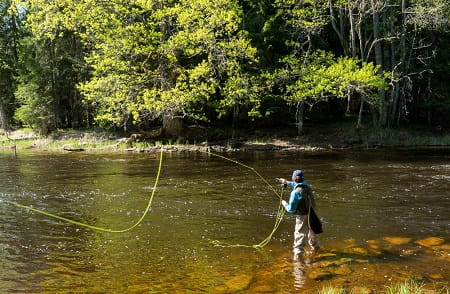
The Lower Fly Fishing Zone is between Beaverdam Brook and the County Route 52 Bridge in Altmar.
The Upper Fly Fishing Zone is located directly downstream of the tailrace of the LightHouse Hill Reservoir, which runs above the Salmon River Fish Hatchery.
From September 15 to May 15, the Lower Fly Zone is open. The Upper Fly Zone is open for fishing Between April 1 and November 30. Dates are subject to change without notice so be sure to check the official fishing regulations before you go and pay attention to the signs on the river.
There are various spots from which anglers can access the Salmon River. Parking is permitted in defined areas, and fishing is allowed in multiple locations. State-maintained parking areas are available at large pools and holes. In addition, numerous roads, including routes 11, 13, and 81, provide access to the river.
The river runs parallel to private land, but the trail’s full length is easily accessible. In addition, there are well-defined walkways on both sides. As you may expect, this river may become congested during salmon season, but anglers who are willing to walk further from the parking areas might find some solitude.
Salmon River All-Tackle Areas
Numerous DEC parking lots and public access spots to the Salmon River are located between Altmar and the city of Pulaski.
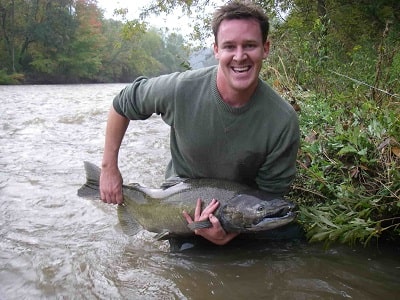
This section of the river is open to all permitted fishing methods, including spin fishing, center pin fishing, and fly fishing, and is actively fished with all methods, particularly at the peak of the salmon season, which runs from early September to mid-October.
Below Pulaski is the Douglaston Salmon Run (DSR), a 2.5-mile private section of the river’s best salmon and steelhead water. The daily rod cost for fishing the DSR is $45 per person (at the time of this writing).
Because anglers need to pay, you may find fewer anglers in this area.
The Salmon River Estuary is located below the DSR and is primarily a Stillwater fishery, best fished by boat. Trolling and casting lures are good methods in this area.
Salmon River Fishing Reports
You can acquire Salmon River fly fishing reports from guides, area fly shops, and websites. Some good examples that stay updated on the current conditions include;
Fishing Regulations on the Salmon River
The Salmon River adheres to Lake Ontario tributary laws detailed in the New York Freshwater Fishing Regulations Guide.
New York state laws require that all persons 16 years of age or older possess a valid fishing license. Sportfishing licenses are offered to residents and non-residents.
You can visit the New York State Department of Environmental Conservation to learn about the most current rules and regulations and obtain a fishing license.
NOTE: Fishing regulations can change at any time, so be sure you are looking up the regulation for the Salmon River in New York State. It is the responsibility of the angler to check and know the fishing rules and requirements before you fish.
Fishing Seasons in the Salmon River
The availability of fish in the Salmon River varies by season.
Summer Fishing
Anglers are most likely to find resident brown trout and some Atlantic salmon in the summer, but this is not a good time for other salmon fishing.
Fall Fishing
Chinook salmon or kings, dominate the Salmon River in the fall, and these salmon are what attract the large crowds.
Just because there are a lot of salmon in the river does not mean you will catch one. It’s important you know how to set up your leader, use the right gear for these large salmon, and most importantly, you need to know how to fish for king salmon properly.
Coho runs generally occur during the same period, and both salmon varieties can be found at common parts of the river. Be sure you know how to fish for Coho as well.
The runs’ start, end, and duration vary from one year to another. Typically, main runs end by late October, and numerous dead salmon litter the sides of the river.
Winter Fishing
The Coho and Chinook salmon die after they spawn, so the cold winter conditions of late November and December do not favor any decent salmon fishing. However, you may get the occasional Atlantic Salmon that has finished spawning and has not returned to the lake yet.
Spring Fishing
Atlantic salmon may be present in the Salmon River in spring; however, this is rare and usually occurs later in May. Generally, spring is steelhead time only.
Methods of Fishing That Are Best for Salmon River
Below are some of the most effective methods for fishing for salmon on the Salmon River.
Spin Fishing
This fishing technique involves casting bait or lures with a reel equipped with a smooth drag. It provides the perfect natural presentation to the fish since the spool used can hold a lot of lines.
The salmon in the Salmon River, like many of the Great Lakes rivers, will hit the same lures and colors and with the same lure fishing methods, which you can see on my page Lure Fishing For Great Lakes River Salmon.
Fly Fishing
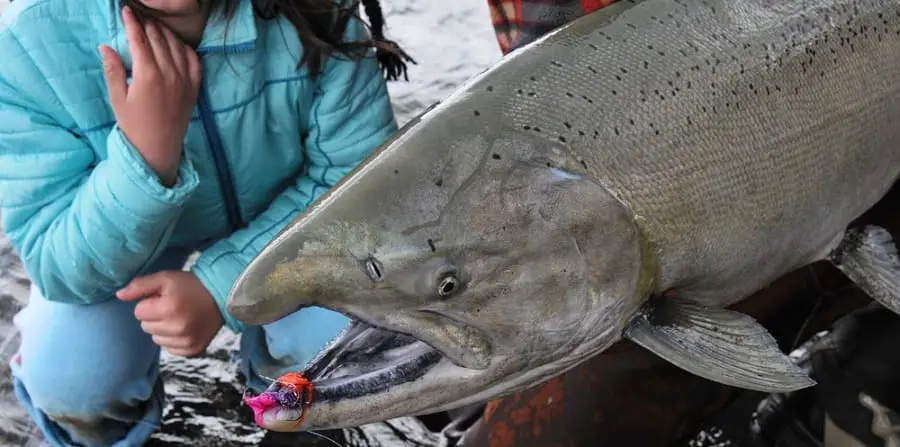
Fly fishing is another excellent method for catching salmon on the Salmon River.
Fly fishing for salmon is quite effective because all salmon species find flies hard to pass up, and flies are less intrusive than other baits, so even the weary and spooked salmon might hit a well-presented fly.
Common salmon fly fishing methods used on the Salmon River include streamer fishing, nymph fishing, Spey fishing, and even Euro Nymph fishing.
Good salmon flies include:
- Egg patterns
- Pheasant tail nymphs
- Worm patterns
- Stonefly nymphs
- Spey Flies like the Hoh Bo Spey or Intruder.
Float Fishing
This popular fishing method involves presenting a bait such as a spawn sac or roe bag under a float or bobber.
Float fishing is very effective, especially in the larger and deeper spots. See Float Fishing For Salmon.
Centerpin Fishing
Centerpin fishing is basically float fishing just using a centerpin reel. Using this type of reel makes float fishing even more effective. See Centerpin Fishing For Salmon: A Complete Guide.
Best Lures, Baits, and Flies for Salmon River Fishing
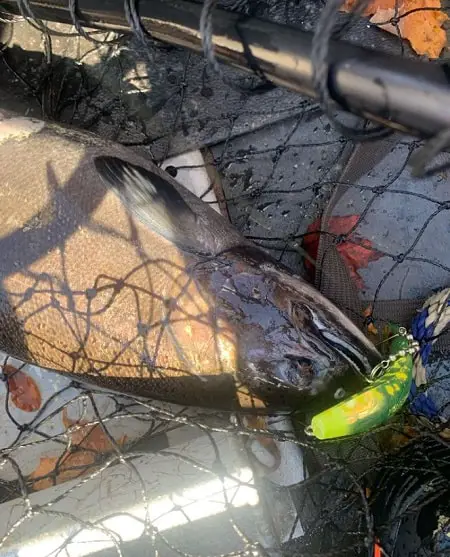
As described below, anglers can use various flies, baits, and lures in the Salmon River.
- Worms
- Beads
- Roe – Spawn sacs in multiple colors and sizes
- Flies
- Spinners
- Spoons
- Crankbaits
- Plugs
See: 10 Best Baits For Salmon.
Salmon River Trip Planning Tips
Pulaski, New York, offers the best access to the Salmon River, and there are plenty of lodges, fishing stores, and places to eat.
If you have a question or some advice on fishing for salmon on the Salmon River, let us know in the comments section below.
Tight Lines,
Graham

Graham, I’ve been fishing the Salmon River NY since 1994, till present… I caught and netted more salmon than steelhead, yet I’ve hooked more steelhead than salmon and never netted a single steelhead. Which has only pushed me to pursue this wonderful fish (steelhead) even more. I’m obsessed with your websites and how you give such detailed info. Thank you for putting all this wonderful information out there, it’s definitely worth reading and learning so much I didn’t know.
Tight Lines,
Jeff Parker
Hey Jeff,
The steelhead on the Salmon River are strong fish but keep at and you will net one soon. I’m happy to hear that my website is helping you out.
Good luck this winter and spring.
Graham